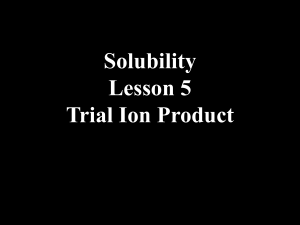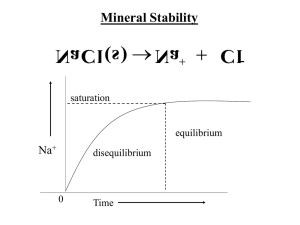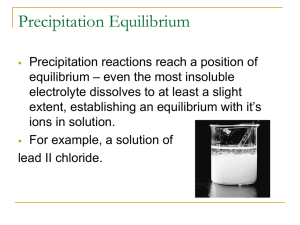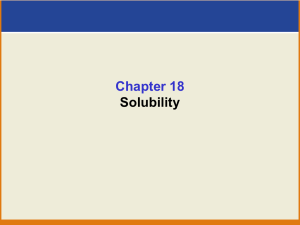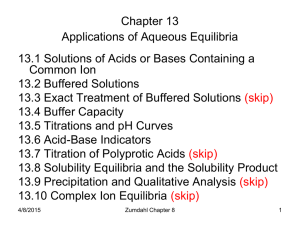Ch 17 notes
advertisement
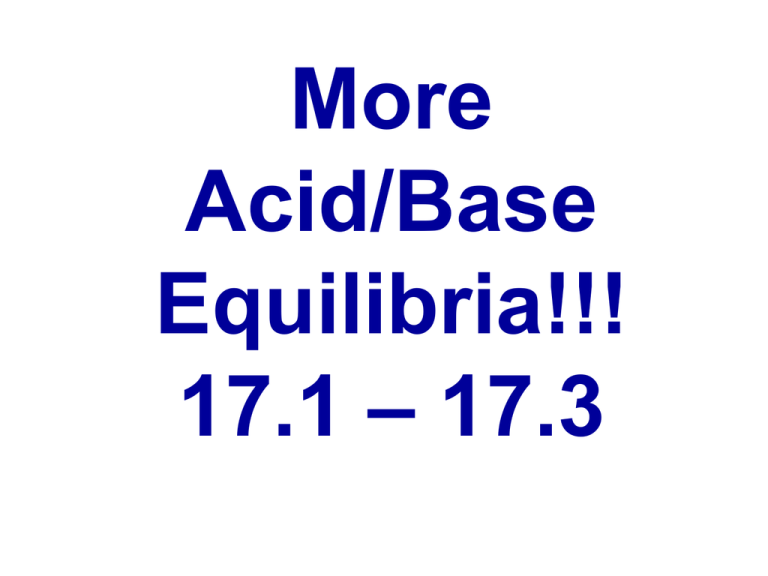
More Acid/Base Equilibria!!! 17.1 – 17.3 17.1 The Common Ion Effect Consider the ionization of a weak acid, acetic acid: HC2H3O2(aq) H+(aq) + C2H3O2–(aq) If we increase the [C2H3O2–] ions by adding NaC2H3O2, the equilibrium will shift to the left. (Le Chatelier) This reduces the [H+] and raises the pH (less acidic) This phenomenon is called the common-ion effect. Common ion equilibrium problems are solved following the same pattern as other equilibrium problems (ICE charts) EXCEPT the initial concentration of the common ion must be considered (it is NOT zero). Example 1: Does the pH increase, decrease, or stay the same on addition of each of the following? (a) NaNO2 to a solution of HNO2 (b) (CH3NH3)Cl to a solution of CH3NH2 (c) sodium formate to a solution of formic acid (d) potassium bromide to a solution of hydrobromic acid (e) HCl to a solution of NaC2H3O2 (a) (b) (c) (d) (e) HNO2 H+ + NO2increases CH3NH2 + H2O CH3NH3+ + OHdecreases HCHO2 H+ + CHO2increases HBr H+ + Brno change C2H3O2-1 + H2O HC2H3O2 + OH-1 decreases Example 2: Using equilibrium constants from Appendix D, calculate the pH of the solution containing 0.060 M KC3H5O2 and 0.085 M HC3H5O2 H C 3 H 5 O 2 (aq) in itial 0.085 change: -x Equilibrium: 0.085-x H +1 -1 (aq) + C 3 H 5 O 2 (aq) 0 0 .060 +x +x x .060+ x (.060 x )( x ) (.085 x ) 1.3 *10 5 x2+.060013x-(1.105*10-6)=0 x=1.84*10-5 pH = -log(1.84*10-5) = 4.74 K a = 1.3 x 10 -5 17. 2 Buffered Solutions A buffered solution or buffer is a solution that resists a change in pH after addition of small amounts of strong acid or strong base. A buffer consists of a mixture of a weak acid (HX) and its conjugate base (X– ) or weak base (B) and its conjugate acid (HB+) Thus a buffer contains both: an acidic species to neutralize added OH– When a small amount of OH– is added to the buffer solution, the OH– reacts with the acid in the buffer solution. a basic species to neutralize added H+ When a small amount of H+ is added to the buffer solution, the H+ reacts with the base in the buffer solution. Composition of a Buffer - 4 ways to make a buffer solution: 1.) Weak acid + salt of the acid HCN and NaCN weak acid: HCN weak base: CN-1 2.) Weak base + salt of the base NH3 and NH4 Cl weak acid: NH4+1 weak base: NH3 3.) EXCESS Weak acid + strong base 2 mol HCN + 1 mol NaOH 1 mol HCN + 1 mol NaCN + H2O weak acid: HCN weak base: CN-1 2 mol NH4Cl + 1 mol NaOH 1 mol NH4Cl + 1 mol NH3 + NaCl weak acid: NH4+1 weak base: NH3 4.) EXCESS Weak base + strong acid 2 mol NH3 + 1 mol HCl 1 mol NH3 and 1 mol NH4Cl weak acid: NH4+1 weak base: NH3 2 mol NaF + 1 mol HCl 1 mol NaF + 1 mole HF + NaCl weak acid: HF weak base: F-1 Example 3: Explain why a mixture of HCl and KCl does not function as a buffer, whereas a mixture of HC2H3O2 and NaC2H3O2 does. HCl is a strong acid - Cl-1 is a negligible base and will NOT react with added H+ - added H+ will significantly change the pH of the solution HC2H3O2 and C2H3O2-1 are a weak conjugate acid/base pair which act as a buffer HC2H3O2 reacts with added base C2H3O2-1 reacts with added acid leaving the [H+1] and pH relatively unchanged Buffer Capacity and pH Buffer capacity is the amount of acid or base that can be neutralized by the buffer before there is a significant change in pH. Buffer capacity depends on the concentrations of the components of the buffer - the greater the concentrations of the conjugate acid-base pair, the greater the buffer capacity. The pH of the buffer is related to Ka and to the relative concentrations of the acid and base. Henderson-Hasselbalch equation – used for buffer solutions (on AP equation sheet!!) p H = p K a + lo g p O H = p K b + lo g A- HA = pK a + HB + B b a se lo g a cid = pK b + a cid lo g b a se a cid fo rm b a se fo rm These equations technically use the equilibrium concentrations of the acid (base) and the conjugate base (acid). However, since the acid/base in the buffer is WEAK – the amount of the conjugate produced by dissociation is generally small compared to the amount of the conjugate added as a salt. IF this is true (it is for all AP buffer problems!) we do not need to do an equilibrium problem – just use the INITIAL concentrations. Example 4 (Example 2 again!): Using equilibrium constants from Appendix D, calculate the pH of the solution containing 0.060 M KC3H5O2 and 0.085 M HC3H5O2 H C 3 H 5 O 2 (aq) in itial 0.085 H +1 0 -1 (aq) + C 3 H 5 O 2 (aq) K a = 1.3 x 10 0 .060 this is a BUF F ER solution - use the H enerdson-H asslebalch equation use the initial concentrations ! p H = p K a + log 0.060 -5 = - log(1.3 x 10 ) + log = [acid ] 0.085 [b ase] 4.73 -5 Example 5: Calculate the pH of a buffer that is 0.12 M in lactic acid and 0.11 M in sodium lactate H C H O 2 (aq) in iti al H +1 -1 (aq) + C H O 2 (aq) 0.12 K a 1.4 x 1 0 -4 0. 1 1 Using the H enderson-H asselbalch equation (and initial conc) pH = pK a 0.11 + log = - log(1.4 x 10 ) + log = 3.85 - .038 = 3 .81 [acid] 0.12 [base] -4 yo u w o u ld g et th e sam e an sw er d o in g a co m p lete IC E ch art Example 6: A buffer is prepared by adding 20.0 g of acetic acid, HC2H3O2 and 20.0 g of sodium acetate to enough water to form 2.00 L of solution. (a) Determine the pH of the buffer (b) Write the complete ionic equation for the reaction that occurs when a few drops of hydrochloric acid are added to the buffer (c) Write the complete ionic equation for the reaction that occurs when a few drops of sodium hydroxide are added to the buffer (a) [H C 2 H 3 O 2 ] = -1 2 [C 2 H 3 O ] = 20.0 g H C 2 H 3 O 2 in i tial pH = pK a 2.00 L x 2.00 L H = 0.167 M 60.0 g H C 2 H 3 O 2 20.0 g N aC 2 H 3 O 2 H C 2 H 3 O 2 (aq) x 1 m ol H C 2 H 3 O 2 1 m ol N aC 2 H 3 O 2 = 0.1 22 M 82.0 g N aC 2 H 3 O 2 +1 -1 (aq) + C 2 H 3 O 2 (aq) 0.167 K a = 1.8 x 10 -5 0.122 0.122 + log = - log(1.8 x 10 ) + log = 4.74 - .14 = 4.60 [acid] 0.16 7 [base] -5 (b) C2H3O2-1(aq) + H+1(aq) + Cl-1(aq) HC2H3O2 (aq) + Cl-1 (aq) (c) HC2H3O2 (aq) + Na+1 (aq) + OH-1 (aq) C2H3O2-1 (aq) + H2O (l) + Na+1 (aq) 17.3 Acid-Base Titrations – Titration Curves In an acid-base titration: A solution of base (or acid) of known concentration (called standard) is added to an acid (or base). Acid-base indicators or a pH meter are used to signal the equivalence point (when moles acid = moles base). The plot of pH versus volume during a titration is called a pH titration curve. Starts high Ends low Equivalence point = 7 equal moles of acid and base present end start Strong acid added to strong base Starts low Ends high Equivalence point = 7 end start Strong base added to strong acid Starts med-high Ends low Equivalence point < 7 Buffer area – in this area there is weak base and some salt of the weak base Actual pH depends on the salt formed but it will be < 7 Strong acid added to weak base Starts low Ends med-high Equivalence point < 7 end start Weak base added to strong acid Starts high Ends med-low Equivalence point > 7 Actual pH depends on the salt formed but it will be > 7 end start Weak acid added to strong base Starts med-high Ends med-low Equivalence point = 7 end start Weak acid added weak base Strong base added to strong diprotic acid (H2SO4) Example 7: Predict whether the equivalence point of each of the following titrations is below, above or at pH 7: a) NaHCO3 titrated with NaOH b) NH3 titrated with HCl c) KOH titrated with HBr At the equivalence point, only products are present in solution, so determine the products of the reaction and then determine if the solution is acidic, basic or neutral a) NaHCO3 + NaOH Na2CO3 + H2O weak acid strong base pH > 7 CO3-2 is basic, Na+ is neutral, H2O is neutral b) NH3 + HCl NH4Cl weak base strong acid pH < 7 NH4+1 is acidic, Cl- is neutral c) KOH + HBr KBr + H2O strong base strong acid pH = 7 K+ and Br- are both neutral Example 8: How many mL of 0.0850 M NaOH solution is required to titrate 40.0 mL of 0.0900 M HNO3? ? mL 40.0 mL 0.0850 M 0.0900 M NaOH + HNO3 1 mole 1 mole 0.0400 L H N O 3 x 0.090 m ol H N O 3 1 L HNO 3 x H2O + 1 m ol N aO H 1 m ol H N O 3 NaNO3 x 1 L N aO H 0.0850 m ol N aO H = 0.0423 L or 42.3 m L Example 9: A 20.0 mL sample of 0.200 M HBr solution is titrated with 0.200 M NaOH solution. Calculate the pH of the solution after the following volumes of base solution have been added: (a) 15.0 mL (b) 19.9 mL (c) 20.0 mL (d) 20.1 mL (e) 35.0 mL (a) mL HBr mL NaOH mL Total mol H+1 (M) (V) mol OH-1 (M) (V) M of excess ion (mol / tot vol) pH 20.0 15.0 35.0 0.00400 0.00300 0.0286 M H+1 1.544 (.200)(.0200) (.200)(.0150) (.004 .003) m ol - log(.0286) 0.0350 L (b) 20.0 19.9 39.9 0.00400 0.00398 0.0005 M H+1 3.3 (c) 20.0 20.0 40.0 0.00400 0.00400 1 x 10-7 M H+1* 7.0 (d) 20.0 20.1 40.1 0.00400 0.00402 0.0005 M OH-1 10.7 35.0 55.0 0.00400 0.00700 0.0545 M OH-1 12.736 (e) 20.0 When molarity of H+ (or OH-) is less than 10-6 we must consider the autoionization of water! (H+ = 1.0*10-7) Example 10: Calculate the pH at the equivalence point for titrating 0.200 M solutions of each of the following bases with 0.200 M HBr: (a) NaOH (b) NH2OH (a) strong acid/strong base titration so pH = 7 (b) HBr + NH2OH Br- + NH2OH2+ strong acid weak base .200M .200M all product at equivalence point – no excess & Br- is neutral and will have no affect on pH Volume doubles (equal molarity and 1:1 stoich ratio) so molarity halves [NH2OH2+] = 0.200mol / 2 = 0.100 M I C E NH2OH2+ H+1 + NH2OH Kb = 1.1 x 10-8 (appendix) .100 0 0 -x +x +x 0.100 – x x x Ka = Kw / Kb = 1 10-14 / 1.1 10-8 = 9.1 10-7 (x2) / (0.100-x) = 9.1 x 10-7 x = 3.0 x 10-4 M = [H+1] pH = - log(3.0 x 10-4) = 3.52 Acid – Base Indicators The equivalence point of an acid-base titration can be determined by measuring pH, but it can also be determined by using an acid-base indicator which marks the end point of a titration by changing color. Although the equivalence point (defined by the stoichiometry) is not necessarily the same as the end point (where the indicator changes color), careful selection of the indicator can ensure that the difference between them is negligible. Acid-base indicators are complex molecules that are themselves, weak acids (represented by HIn). They exhibit one color when the proton is attached and a different color when the proton is absent. Acid – Base Indicators Bromthymol Blue Indicator In Acid In Base Acid – Base Indicators Methyl Orange Indicator In Acid In Base Acid – Base Indicators Phenolphthalein color at different pH values pH values 5 6 7 8 9 Acid – Base Indicators Consider a hypothetical indicator, HIn, a weak acid with Ka=1.0x10-8. It has a red color in acid and a blue color in base. HIn(aq) H+1(aq) + In-1(aq) red blue Ka = [H ][In ] [H In ] Ka Ka [In ] [In ] = or = [H ] [H In ] [H In ] [H ] R e arranging , w e get S uppose w e add a few drops of indicator to an acid solution 1 w hose pH = 1.0 ([H ] = 1.0 x 10 ) [In ] [H In ] = Ka [H ] = 1.0 x 10 1.0 x 10 8 1 = 10 7 = 1 10,000,000 Acid – Base Indicators HIn(aq) H+1(aq) + In-1(aq) red blue 1 1 0 ,0 0 0 ,0 0 0 = [In ] [H In ] This ratio shows that the predominant form of the indicator is HIn, resulting in a red solution. As OH-1 is added (like in a titration) [H+1] decreases and the equilibrium shifts to the right, changing HIn to In-. At some point in the titration, enough of the In- form will be present so we start to notice a color change. Acid – Base Indicators It can be shown (using the Henderson-Hasselbalch equation) that for a typical acid-base indicator with dissociation constant, Ka, the color transition occurs over a range of pH values given by pKa ± 1. For example, bromthymol blue with Ka = 1.0 x 10-7 (pKa = 7), would have a useful pH range of 7 ± 1 or from 6 to 8. You want to select an indicator whose pKa value is close to the pH you want to detect (usually the pH at the equivalence point) Acid – Base Indicators The pH curve for the titration of 100.0 mL of 0.10 M HCl with 0.10 M NaOH. Neither of the indicators shown would be useful for a titration. Bromthymol blue (pKa=7) would be useful. The pH curve for the titration of 50 mL of 0.1 M HC2H3O2 with 0.1 M NaOH. Here, phenolphthalein is the indicator of choice. It has a pKa value of about 9. Example 11: Use the following table to determine which of the following would be the best indicator to use to indicate the equivalence point of the titrations described in Example 10. Indicator Ka Methyl Yellow 1*10-4 Methyl Red 1*10-5 Bromthymol Blue 1*10-7 Phenolpthalein 1*10-9 a. pH at equivalence point was 7.0 Bromthymol Blue b. pH at equivalence point was 3.52 Methyl Yellow Solubility Equilibria & Complex Ions 17.4 – 17.6 Know your solubility rules: SOLUBILITY GUIDELINES Soluble Compounds Exceptions NOT precipitates PRECIPITATES Nitrates None Acetates None Chlorates None Chlorides Ag+1, Hg2+2, Pb+2 Bromides Ag+1, Hg2+2, Pb+2 Iodides Ag+1, Hg2+2, Pb+2 Sulfates Ca+2, Sr+2, Ba+2, Hg2+2, Pb+2 We classify these based on the Solubility - maximum amount of solute that dissolves in water. Insoluble Compounds Exceptions PRECIPITATES NOT Precipitates Sulfides NH4+1, Li+1, Na+1, K+1, Ca+2, Sr+2, Ba+2 Carbonates NH4+1, Li+1, Na+1, K+1 Phosphates NH4+1, Li+1, Na+1, K+1 Hydroxides Li+1, Na+1, K+1, Ca+2, Sr+2, Ba+2 Chromates NH4+1, Li+1, Na+1, K+1, Ca+2, Mg+2 17.4 Solubility Equilibria The Solubility-Product Constant, Ksp Consider a saturated solution of BaSO4 in contact with solid BaSO4. We can write an equilibrium expression for the dissolving of the solid. BaSO4(s) Ba2+(aq) + SO42–(aq) Since BaSO4(s) is a pure solid, the equilibrium expression depends only on the concentration of the ions. Ksp = [Ba2+][ SO42–] Ksp is the equilibrium constant for the equilibrium between an ionic solid solute and its saturated aqueous solution. Ksp is called the solubility-product constant • In general: the solubility product is equal to the product of the molar concentration of ions raised to powers corresponding to their stoichiometric coefficients. Al2(CO3)3 2 Al+3 + 3 CO3-2 Ksp = [Al+3]2 [CO3-2]3 Solubility and Ksp Solubility is the amount of substance that dissolves to form a saturated solution. This can be expressed as grams of solid that will dissolve per liter of solution. Molar solubility - the number of moles of solute that dissolve to form a liter of saturated solution. Solubility can be used to find Ksp and Ksp can be used to find solubility (see problems) Example 1: a. If the molar solubility of CaF2 at 35oC is 1.24 10-3 mol/L, what is Ksp at this temperature? CaF2 E .00124M actually dissolves Ca+2 .00124 M + 2 F-1 2(.00124) = .00248 M Ksp = [Ca+2] [F-1]2 = (.00124 M)(.00248 M)2 = 7.63 x 10-9 b. It is found that 1.1 10-2 g of SrF2 dissolves per 100 mL of aqueous solution at 25oC. Calculate the solubility product of SrF2. [SrF2] = (.011 g / 125.6 g/mole) / .100 L = .00088 M E SrF2 .00088 M Sr+2 .00088 M + 2 F-1 2(.00088) = .00176 M Ksp = [Sr+2] [F-1]2 = (.00088 M)(.00176)2 = 2.7 x 10-9 c. The Ksp of Ba(IO3)2 at 25oC is 6.0 10-10. What is the molar solubility of Ba(IO3)2? Ba(IO3)2 E x Ba+2 + 2 IO3-1 x 2x (x) (2x)2 = 4 x3 = 6.0 x 10-10 x = 5.3 x 10-4 M 17.5 Factors That Affect Solubility Factors that have a significant impact on solubility are: - The presence of a common ion - The pH of the solution Common-Ion Effect Solubility is decreased when a common ion is added. This is an application of Le Châtelier’s principle: Consider the solubility of CaF2: CaF2(s) Ca2+(aq) + 2F–(aq) If more F– is added (say by the addition of NaF), the equilibrium shifts left to offset the increase. Therefore, more CaF2(s) is formed (precipitation occurs). Example 2: Using Appendix D, calculate the molar solubility of AgBr in (a) pure water (b) 3.0 10-2 M AgNO3 solution (c) 0.50 M NaBr solution Br-1 x Ksp = 5.0 10-13 (b) AgBr Ag+1 + Br-1 E x .030 + x x 5.0 10-13 = (.030+x) x x = 1.7 10-11 M Ksp = 5.0 10-13 (c) AgBr Ag+1 + Br-1 x x .50 + x 5.0 10-13 = x (.50+x) x = 1.0 10-12 M Ksp = 5.0 10-13 (a) AgBr Ag+1 E x x 5.0 10-13 = x2 x = 7.1 10-7 M + notice the DECREASED solubility with the common ion in (b) and (c) pH effects Consider: Mg(OH)2(s) Mg2+(aq) + 2 OH–(aq) If OH– is removed, then the equilibrium shifts right and Mg(OH)2 dissolves. OH– can be removed by adding a strong acid (lowering the pH): OH–(aq) + H+(aq) H2O(aq) Another example: CaF2(s) Ca2+(aq) + 2 F–(aq) If the F– is removed, then the equilibrium shifts right and CaF2 dissolves. F– can be removed by adding a strong acid (or lowering pH): F–(aq) + H+(aq) HF(aq) Example 3: Calculate the molar solubility of Mn(OH)2 at (a) pH 7.0 (b) pH 9.5 (c) pH 11.8 the [OH-1] is set by the pH (or pOH) (a) pH = 7.0 so pOH = 7.0 so [OH-1] = 1.00 10-7 Mn(OH)2 Mn+2 + 2 OH-1 x x 1.00 x 10-7 Ksp = [Mn+2][OH-1]2 1.6 10-13 = (x) (1.00 10-7)2 x = 16 M (b) Ksp = 1.6 10-13 pH = 9.5 so pOH = 4.5 so [OH-1] = 3.16 10-5 Mn(OH)2 Mn+2 + 2 OH-1 Ksp = 1.6 10-13 x x 3.16 x 10-5 Ksp = [Mn+2][OH-1]2 1.6 10-13 = (x) (3.16 10-5)2 x = 1.7 10-4 M pH = 11.8 so pOH = 2.2 so [OH-1] = 6.31 10-3 Mn(OH)2 Mn+2 + 2 OH-1 Ksp = 1.6 10-13 x x 6.31 x 10-3 Ksp = [Mn+2][OH-1]2 1.6 10-13 = (x) (6.31 10-3)2 x = 4.0 10-9 M Common ion effect – increasing [OH-] decreases solubility (c) Example 4: Which of the following salts will be substantially more soluble in acidic solution than in pure water: (a) ZnCO3 (b) ZnS (c) BiI3 (d) AgCN (e) Ba3(PO4)2 If the anion of the salt is the conjugate base of a weak acid, it will combine with H+1, reducing the concentration of the anion and making the salt more soluble ZnCO3 Zn+2 + CO3-2 the CO3-2 ion will react with the added H+ CO3-2 + H+ HCO3-1 Le Chatelier effect of removing CO3-2 more soluble in acid: ZnCO3, ZnS, AgCN, Ba3(PO4)2 17.6 Precipitation and Separation of Ions Consider the following: BaSO4(s) Ba2+(aq) + SO42–(aq) At any instant in time, Q = [Ba2+][ SO42– ] If Q > Ksp, (too many ions) precipitation occurs until Q = Ksp. If Q = Ksp equilibrium exists (saturated solution) If Q < Ksp, (not enough ions) solid dissolves until Q = Ksp. Selective Precipitation of Ions Removal of one metal ion from a solution of two or more metal ions is called selective precipitation. Ions can be separated from each other based on the solubilities of their salt compounds. Example: If HCl is added to a solution containing Ag+ and Cu2+, the silver precipitates (as AgCl) while the Cu2+ remains in solution Generally, the less soluble ion is removed first! Example 5: Will Ca(OH)2 precipitate if the pH of a 0.050 M solution of CaCl2 is adjusted to 8.0? if Q > than Ksp then precipitation will occur pH = 8.0 so pOH = 6.0 so [OH-1] = 1.0 10-6 M Ca(OH)2 Ca+2 + 2 OH-1 Ksp = 6.5 10-6 .050 1.00 x 10-6 Q = [Ca+2] [OH-1]2 Q = (.050)(1.0 10-6)2 = 5.0 10-14 Q<K so no precipitation occurs Example 6: A solution contains 0.00020 M Ag+1 and 0.0015 M Pb+2 . If NaI is added, will AgI or PbI2 precipitate first? Specify the [I-1] needed to begin precipitation for each cation. the cation needing the lower [I-1] will precipitate first AgI Ag+1 + I-1 .000200 x Ksp = [Ag+1][x] 8.3 10-17 = (.00020)[x] 4.2 10-13 = x = [I-1] PbI2 Pb+2 + 2 I-1 0.0015 x Ksp = [Pb+2][x]2 1.4 10-8 = (.0015)[x]2 3.1 10-3 = x = [I-1] Ksp = 8.3 x 10-17 Ksp = 1.4 x 10-8 AgI will precipitate first at an [I-1] = 4.2 10-13 Complex Ions • Complex ion – a metal ion bonded to one or more Lewis bases. (We saw this with water in chapter 16) • It can happen with other Lewis bases (things that have lone pairs of electrons) • Rule of thumb: The number of Lewis bases (ligands) that a metal ion attracts is equal to double its charge. (Works about 75% of the time!) • Extra Stuff Below… Acid – Base Indicators How much In- must be present for the human eye to detect that the color is different? For most indicators, about 1/10 of the initial form must be converted to the other form before a color change is apparent. We can assume that in the titration of an acid with a base, the [In ] 1 = color change will occur at a pH where [H In ] 10 Acid – Base Indicators Bromthymol blue, an indicator with a Ka = 1.0 x 10-7, is yellow in its HIn form and blue in its In- form. Suppose we put some strong acid in a flask, add a few drops of bromthymol blue and titrate with NaOH. At what pH will the indicator color change first be visible? HIn(aq) H+1(aq) + In-1(aq) yellow blue K a = 1.0 x 10 7 = [H ][In ] [H In ] w e assum e that the color change is visib le w hen [In ] [H In ] = 1 10 thus K a = 1 x 10 7 = [H ](1) (10) and [H ] = 1.0 x 10 6 or pH = 6.00 Selective Precipitation of Ions (continued) Sulfide ion is often used to separate metal ions. Example: Consider a mixture of Zn2+(aq) and Cu2+(aq). CuS (Ksp= 6 x 10–37) is less soluble than ZnS (Ksp= 2 x 10–25). Because CuS is LESS SOLUBLE than ZnS, CuS will be removed from solution before ZnS. As H2S is bubbled through the acidified green solution, black CuS forms. When the precipitate is removed, a colorless solution containing Zn2+(aq) remains. When more H2S is added to the solution, a second precipitate of white ZnS forms. Formula Type of acid or base HCl Formula of Hydrolysis equation conjugate of the acid acid or base Strong acid Cl-1 HOCl Weak acid OCl-1 NH3 Weak base NH4+1 Ba(OH)2 Strong base KI neutral H2O K+1 or I-1 Hydrolysis equation of the base HCl + H2O H3O+1 + Cl-1 Cl-1 + H2O X HOCl + H2O H3O+1 + OCl-1 OCl-1 + H2O HOCl + OH-1 NH4+1 + H2O H3O+1 + NH3 NH3 + H2O OH-1 + NH4+1 H2O + H2O H3O+1 + OH-1 OH-1 + H2O X I-1 + H2O X K+1 + H2O X NaC2H3O2 weak base HC2H3O2 HC2H3O2 + H2O H3O+1 + C2H3O2-1 C2H3O2-1 + H2O HC2H3O2 + OH-1




